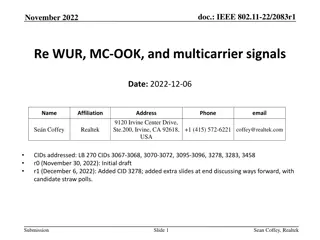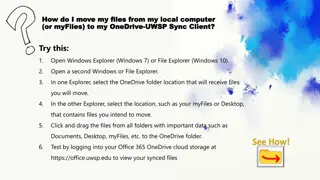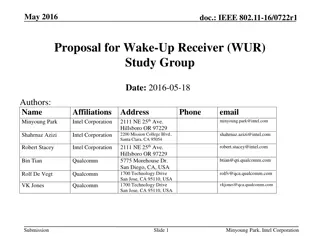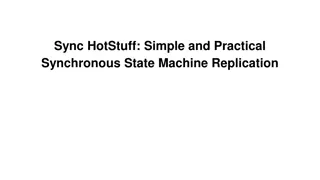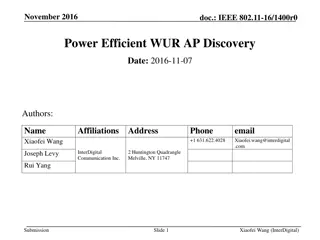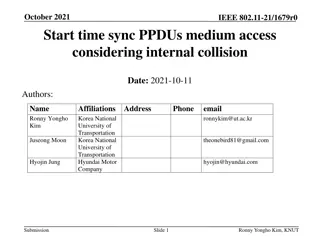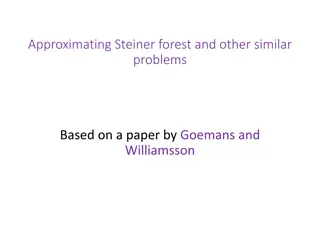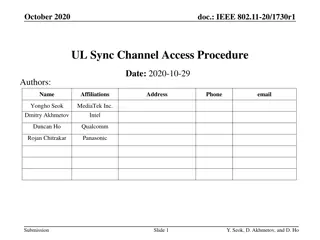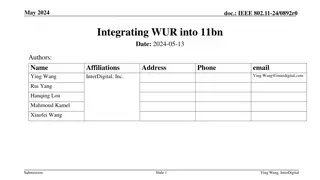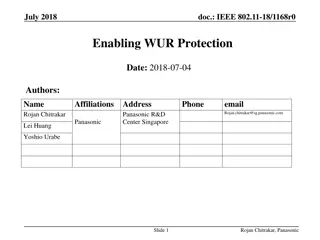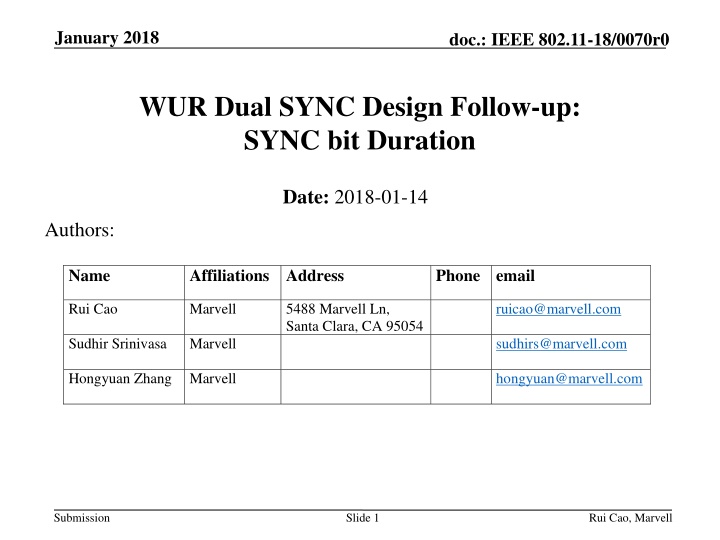
IEEE 802.11-18/0070r0 WUR Dual SYNC Design Review
Explore the impact of SYNC bit duration in the IEEE 802.11-18/0070r0 document related to Dual SYNC design for WUR. Evaluate the structure, sequences, and simulation settings discussed in the document for improved performance.
Download Presentation

Please find below an Image/Link to download the presentation.
The content on the website is provided AS IS for your information and personal use only. It may not be sold, licensed, or shared on other websites without obtaining consent from the author. If you encounter any issues during the download, it is possible that the publisher has removed the file from their server.
You are allowed to download the files provided on this website for personal or commercial use, subject to the condition that they are used lawfully. All files are the property of their respective owners.
The content on the website is provided AS IS for your information and personal use only. It may not be sold, licensed, or shared on other websites without obtaining consent from the author.
E N D
Presentation Transcript
January 2018 doc.: IEEE 802.11-18/0070r0 WUR Dual SYNC Design Follow-up: SYNC bit Duration Date: 2018-01-14 Authors: Name Affiliations Address Phone email Rui Cao Marvell 5488 Marvell Ln, Santa Clara, CA 95054 ruicao@marvell.com Sudhir Srinivasa Marvell sudhirs@marvell.com hongyuan@marvell.com Hongyuan Zhang Marvell Submission Slide 1 Rui Cao, Marvell
January 2018 doc.: IEEE 802.11-18/0070r0 Introduction In IEEE November meeting, long-short dual SYNC design structure is agreed [1, 2] with 250kbps uses 64us SYNC 62.5kbps uses 128us SYNC The SYNC sequence and each SYNC bit duration is not decided In this contribution, we evaluate the impact of SYNC bit duration. Submission Slide 2 Rui Cao, Marvell
January 2018 doc.: IEEE 802.11-18/0070r0 Recap: Long-short Dual SYNC Design Dual sequence design Design one base sequence S of length N (sequence of 1s and 0s). High-rate (250kbps) uses complementary [1-S] of duration 64us Low-rate (62.5kbps) uses [S S] of duration 128us For the same duration, WUR SYNC can use different combinations of bit duration and sequence length, for example: 4us with 16 bit S sequence shorter S sequence may save receiver local correlator template storage 2us with 32 bit S sequence twice longer S sequence can provide better correlation properties: higher peak-to-sidelobe ratio and faster correlation peak roll-off. Provide better carrier sensing/timing performance, and potentially easier receiver tuning: large range of good SYNC detection ratio Submission Slide 3 Rui Cao, Marvell
January 2018 doc.: IEEE 802.11-18/0070r0 Examples of SYNC Sequences Only consider SYNC bit duration of 2us and 4us: WUR OOK modulation already has ON waveform definition of both for Manchester coding No need to redefine ON waveform for these two durations Sequence design criteria: good correlation property S is designed from an M-sequence of length N-1. Add one extra 1 or 0 to achieve zero DC receiver correlator template and good cross-correlation and auto-correlation properties [3]. Two examples: N= 32 and 2us bit duration Z = [1 0 1 1 1 0 0 0 1 0 1 0 1 1 0 1 0 0 0 0 1 1 0 0 1 0 0 1 0 1 1 1]; N= 16 and 4us bit duration Z = [0 1 1 1 0 0 0 1 0 0 1 1 0 1 0 1]; Submission Slide 4 Rui Cao, Marvell
January 2018 doc.: IEEE 802.11-18/0070r0 Simulation Settings WUR Packet WUR Data signal uses center ~4MHz in 20MHz bandwidth Payload: 48 bits, Manchester Coding 2ms noise appended before the WUR packet SNR defined on 20MHz noise CFO = 20ppm, fc = 2.4GHz, No phase noise Receiver Realistic AGC: entire packet is normalized to certain gain target BPSK Symbol 2ms noise WUR Data LLTF LSIG WUR SYNC LSTF Noise portion normalized based on the noise power WUR portion normalized by 20MHz preamble power 3th order 4MHz butterworth filter with 2.5MHz cutoff frequency 4MHz sampling rate with in-phase path CS detection threshold is chosen to have <1% Pfalse rate Submission Slide 5 Rui Cao, Marvell
January 2018 doc.: IEEE 802.11-18/0070r0 Channel: AWGN WUR DualSync, AWGN, RxSampling:4MHz, 250kbps WUR DualSync, AWGN, RxSampling:4MHz, 62.5kbps 0 0 10 10 PER: IdealTiming PER: 4usSYNC PER: 2usSYNC Pmiss: 4usSYNC Pmiss: 2usSYNC -1 10 -1 10 PER PER -2 10 PER: IdealTiming PER: 4usSYNC PER: 2usSYNC Pmiss: 4usSYNC Pmiss: 2usSYNC -2 10 -3 10 -10 -8 -6 -4 -2 0 2 4 -10 -8 -6 -4 -2 0 2 4 6 SNR(dB) SNR(dB) 62.5kbps: 2us SYNC has slightly better performance than 4us SYNC 250kbps: 2us SYNC is ~1.6dB better than 4us SYNC Submission Slide 6 Rui Cao, Marvell
January 2018 doc.: IEEE 802.11-18/0070r0 Channel: DNLOS WUR DualSync, DNLos, RxSampling:4MHz, 250kbps WUR DualSync, DNLos, RxSampling:4MHz, 62.5kbps 0 0 10 10 PER: IdealTiming PER: 4usSYNC PER: 2usSYNC Pmiss: 4usSYNC Pmiss: 2usSYNC PER: IdealTiming PER: 4usSYNC PER: 2usSYNC Pmiss: 4usSYNC Pmiss: 2usSYNC -1 -1 10 10 PER PER -2 -2 10 10 -3 -3 10 10 -10 -5 0 5 10 15 -10 -8 -6 -4 -2 0 2 4 6 8 10 SNR(dB) SNR(dB) 62.5kbps: 2us SYNC has slightly better performance than 4us SYNC 250kbps: 2us SYNC is ~0.8dB better than 4us SYNC Submission Slide 7 Rui Cao, Marvell
January 2018 doc.: IEEE 802.11-18/0070r0 Channel: UMi-NLos WUR DualSync, UMi-NLOS, RxSampling:4MHz, 62.5kbps WUR DualSync, UMi-NLOS, RxSampling:4MHz, 250kbps 0 0 10 10 PER: IdealTiming PER: 4usSYNC PER: 2usSYNC Pmiss: 4usSYNC Pmiss: 2usSYNC -1 -1 10 10 PER PER -2 -2 10 10 PER: IdealTiming PER: 4usSYNC PER: 2usSYNC Pmiss: 4usSYNC Pmiss: 2usSYNC -3 -3 10 10 -10 -8 -6 -4 -2 0 2 4 6 8 10 -10 -5 0 5 10 15 SNR(dB) SNR(dB) 62.5kbps: 2us SYNC has slightly worse performance than 4us SYNC 250kbps: 2us SYNC has slightly higher error floor, due to long delay spread Submission Slide 8 Rui Cao, Marvell
January 2018 doc.: IEEE 802.11-18/0070r0 Sensitivity Comparison AWGN 62.5kbps 250kbps Pmiss PER delta Pmiss PER delta 4us -5.4 dB -5.2 dB 0.2 dB -2.7 dB 2.4 dB 5.1 dB 2us -5.6 dB -5.3 dB 0.3 dB -3.4 dB 0.8 dB 2.6 dB 62.5kbps 250kbps Pmiss PER delta Pmiss PER delta 4us -0.6 dB -0.3 dB 0.3 dB 2.5 dB 6.2 dB 3.7 dB 2us -1.4 dB -1.0 dB 0.4 dB 1.5 dB 5.0 dB 3.5 dB UMi-Nlos 62.5kbps 250kbps Pmiss PER delta Pmiss PER delta 4us -1.7 dB -1.6 dB 0.1 dB 1.8 dB x x 2us -1.6 dB -1.3 dB 0.3 dB 1.4 dB x x Submission Slide 9 Rui Cao, Marvell
January 2018 doc.: IEEE 802.11-18/0070r0 Discussion SYNC bit duration of 2us shows some performance advantage over 4us SYNC The SNR gain of SYNC bit duration of 2us will depend on multiple receiver design parameters: receiver analog design (low-pass filter, AGC, and etc.), receiver sampling rate, SYNC detection threshold setting, DATA OOK detection algorithm and etc. SYNC bit duration of 2us enables the possibility for receiver to achieve better sensitivity The sensitivity gain is accompanied by additional power consumption at low SNR. For example, SNR<-5dB, the high-rate PER is close to 1, better CS detection (smaller Pmiss) of 2us design will induce more receiver data decoding trials, resulting in slightly higher power consumption This wrong packet length detection can also cause CCA issues, if a different length design option is allowed on the MAC side Submission Slide 10 Rui Cao, Marvell
January 2018 doc.: IEEE 802.11-18/0070r0 Straw Poll 1 Do you agree that duration of each 11ba SYNC bit to be 2us and the base sequence S of length 32? Y: N: A: Submission Slide 11 Rui Cao, Marvell
January 2018 doc.: IEEE 802.11-18/0070r0 Reference [1] IEEE 802.11-17/1781r1, SYNC Structure Motions [2] IEEE 802.11-17/1618r1, Dual SYNC Design and Performance. [3] IEEE 802.11-17/1343r0, WUR preamble SYNC design and performance Submission Slide 12 Rui Cao, Marvell





